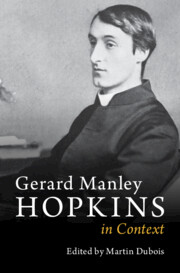Book contents
- Gerard Manley Hopkins in Context
- Gerard Manley Hopkins in Context
- Copyright page
- Contents
- Illustrations
- Notes on Contributors
- Note on Editions and Abbreviations
- Chronology
- Introduction
- Part I Places
- Part II Aesthetic and Cultural Contexts
- Part III Religious, Theological, and Philosophical Contexts
- Part IV Nature, Science, and the Environment
- Part V Gender, Sexuality, and the Body
- Part VI Form, Genre, and Poetics
- Chapter 25 Rhythm
- Chapter 26 Language
- Chapter 27 Address
- Chapter 28 Syntax
- Chapter 29 Rhyme
- Chapter 30 Ode
- Chapter 31 Sonnet
- Chapter 32 Letters
- Chapter 33 Journal Prose
- Chapter 34 Sermons
- Part VII Reception and Influence
- Further Reading
- Index
Chapter 25 - Rhythm
from Part VI - Form, Genre, and Poetics
Published online by Cambridge University Press: 16 January 2025
- Gerard Manley Hopkins in Context
- Gerard Manley Hopkins in Context
- Copyright page
- Contents
- Illustrations
- Notes on Contributors
- Note on Editions and Abbreviations
- Chronology
- Introduction
- Part I Places
- Part II Aesthetic and Cultural Contexts
- Part III Religious, Theological, and Philosophical Contexts
- Part IV Nature, Science, and the Environment
- Part V Gender, Sexuality, and the Body
- Part VI Form, Genre, and Poetics
- Chapter 25 Rhythm
- Chapter 26 Language
- Chapter 27 Address
- Chapter 28 Syntax
- Chapter 29 Rhyme
- Chapter 30 Ode
- Chapter 31 Sonnet
- Chapter 32 Letters
- Chapter 33 Journal Prose
- Chapter 34 Sermons
- Part VII Reception and Influence
- Further Reading
- Index
Summary
This chapter argues that we must understand Hopkins’s engagement with rhythm amid the cultural contexts of poetic experimentation and metrical and linguistic inquiry during the nineteenth century, a prosodic discourse in which Hopkins was a participant. Amid linguistic and religious definitions of tradition and rupture, Hopkins thought through several changing definitions of rhythm in language, in poetry and in the world. Our focus on sprung rhythm, though his most well-known innovation, clouds other theories of rhythms and important cultural histories of accent, speech, national identity, and religious identification that show the ways that accent and stress are part of a broader pattern – a broader rhythm he wants to detect – of likeness and difference in all things.
- Type
- Chapter
- Information
- Gerard Manley Hopkins in Context , pp. 219 - 227Publisher: Cambridge University PressPrint publication year: 2025

